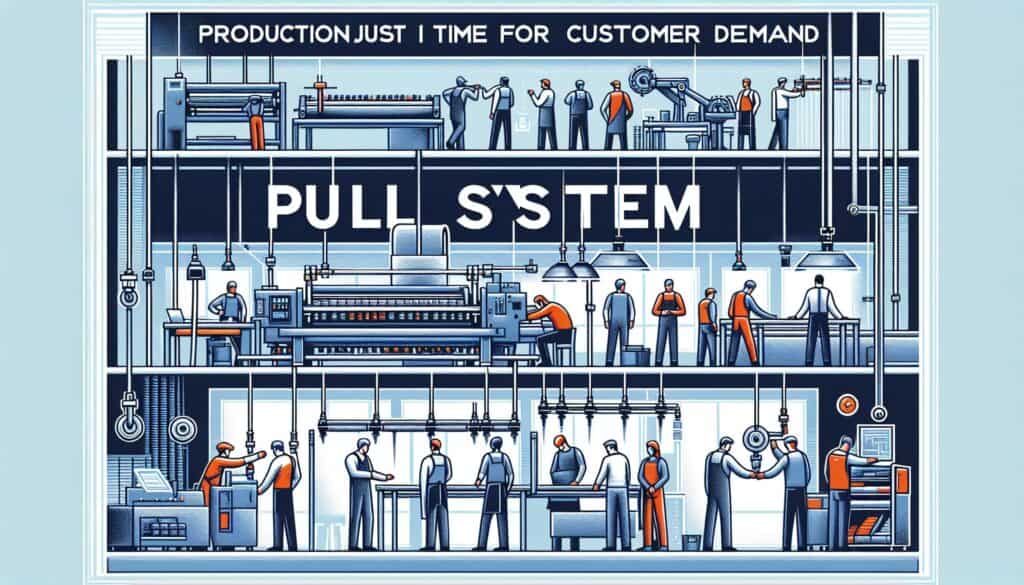Produrre articoli solo quando sono necessari per la fase successiva del processo o per il cliente, riducendo al minimo la sovrapproduzione e le scorte.
- Metodologie: Ingegneria, Qualità
Sistema di trazione

Sistema di trazione
- Miglioramento continuo, Just-in-Time (JIT), Kanban, Produzione snella, Miglioramento dei processi, Efficienza della produzione, Catena di approvvigionamento, Mappatura del flusso di valore, Strategie di eliminazione dei rifiuti
Obiettivo:
Come si usa:
- A Lean manufacturing principle where downstream activities signal their needs to upstream activities. Work is "pulled" through the system based on actual demand, often using tools like Kanban cards.
Professionisti
- Riduce gli sprechi (in particolare la sovrapproduzione e le scorte); migliora l'efficienza e la reattività dei flussi; riduce i costi di stoccaggio; aumenta la soddisfazione dei clienti grazie alla puntualità delle consegne.
Contro
- Richiede fornitori affidabili e una domanda stabile per ottenere prestazioni ottimali; può essere difficile da implementare in catene di fornitura complesse o con una domanda altamente variabile; richiede un'esecuzione e una comunicazione disciplinate.
Categorie:
- Lean Sigma, Produzione
Ideale per:
- Controllo del flusso di risorse in un processo di produzione, sostituendo solo ciò che è stato consumato, in base alla domanda effettiva dei clienti.
The Pull System methodology is prominently utilized in various industries such as automotive, electronics, and consumer goods, where customer demands fluctuate and need accurate synchronization with production processes. This approach is particularly effective during the production phase where ongoing assessment of consumer need dictates the pace of manufacturing, thereby facilitating a more agile response to market changes. Participants in this methodology typically include cross-functional teams that engage in transparent communication, allowing for real-time data sharing and decision-making based on actual consumption rather than forecasts. For example, in the automotive industry, manufacturers often employ Kanban boards to visualize workflow and inventory status, ensuring that components are replenished as they are used, thereby minimizing excess stock and associated carrying costs. By encouraging workers on the assembly line to signal when parts are needed, organizations can ensure that they are only producing what is required by the next step in the process. This not only enhances operational efficiency but also contributes to a culture of continuous improvement where feedback loops inform adjustments in production strategy. Tools such as value stream mapping often accompany the Pull System to identify and eliminate waste, fostering an environment of continuous refinement. Such methodologies have been integral in enhancing customer satisfaction by optimizing lead times and increasing product availability without the burden of overproduction.
Fasi chiave di questa metodologia
- Identify the final product and its requirements from customer feedback.
- Map the value stream to visualize processes and identify wasteful practices.
- Define pull signals, such as Kanban cards, to indicate when to produce or move items.
- Implement systems to react to pull signals, adjusting production based on demand.
- Establish limits for work in progress (WIP) to enhance flow control and efficiency.
- Continuously review and refine processes to align with actual customer needs.
- Train all team members on the pull system principles and their applications.
- Encourage proactive communication and feedback between upstream and downstream processes.
Suggerimenti per i professionisti
- Implement robust visual management techniques to enhance visibility of work in progress and real-time status updates for improved decision-making.
- Regularly analyze lead times and cycle times to identify bottlenecks and continually refine the pull system for optimal performance.
- Encourage cross-functional collaboration to ensure alignment between production and demand signals, enhancing responsiveness and agility.
Leggere e confrontare diverse metodologie, raccomandiamo il
> Ampio archivio di metodologie <
insieme ad altre 400 metodologie.
I vostri commenti su questa metodologia o ulteriori informazioni sono benvenuti su sezione commenti qui sotto ↓ , così come tutte le idee o i link relativi all'ingegneria.
Contesto storico
1930
1940
1950
1950
1958
1960
1960
1930
1940
1949
1950
1950
1960
1960
1960
(se la data non è nota o non è rilevante, ad esempio "meccanica dei fluidi", viene fornita una stima approssimativa della sua notevole comparsa)















Post correlati
Simulazione di Monte Carlo
Test basati su modelli
Controllo del modello
Ricerca con metodi misti
A prova di errore (Poka-Yoke)
Test del profilo di missione